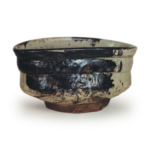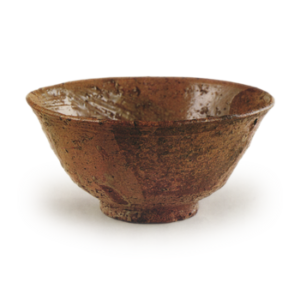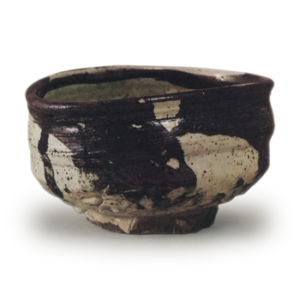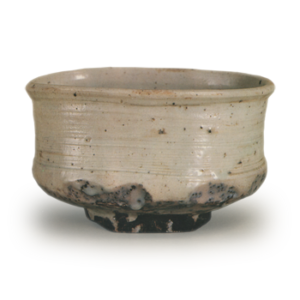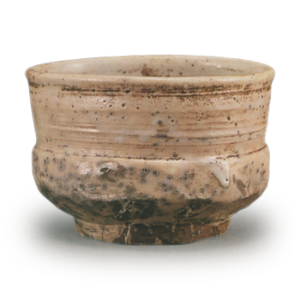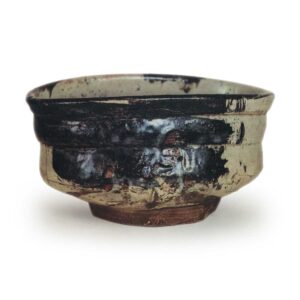
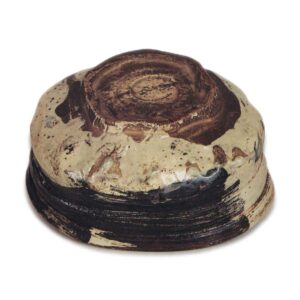
Held in the Hatakeyama Memorial Museum
Height: 6.5 – 7.4 cm
Diameter: 10.3 – 14.0 cm
Outer diameter of foot ring: 6.5 – 7.1 cm
Height: 0.7 – 1.0 cm
The name “Katada” is written in ink on the inside of the lid, but the origin of the name is unclear. According to the Taisho Meiki Kan (A Guide to Famous Tea Bowls from the Taisho Period), the name is thought to be derived from the Omi Hakkei (Eight Views of Omi) painting of the Katada Rakugan (falling wild geese) scene, as the black brush strokes around the outside of the tea bowl resemble the shape of a wild goose.
In addition to this tea bowl, six Gosomaru tea bowls are listed in the Taisho Meiki Kan (Famous Tea Bowl Catalogue of the Taisho Period) and are generally known, including the “Sunset” bowl in the Fujita Art Museum collection, the “Scarlet Hakama” bowl that belonged to the Fujita Heitaro family, and the bowls that belonged to the Mitsui Hachiroemon family, the Iwasaki Koyata family, and the Wada Kyuzaburo family. It is thought that these six bowls are the only ones that have survived. The Gosomaru tea bowl is clearly in the style of Furuta Oribe, that is, it is a tea bowl in the Oribe-kirigata style. Furthermore, in the case of the Gosomaru, the style of each part is more clearly stylized than in the so-called Oribe-kutsu, and it can be said to be a product with a strong character as a special order item. It is thought that it was made around the Keicho period.
Like the other Gosho-maru, this Katata is also shaped like a kutsu, with a rounded, beaded rim and a slightly open mouth. The body is fastened with two bands at the center and top, and this tea bowl in particular has a particularly tight, strong, powerful feel. The waist, which is slightly bulging outwards, and the area around the foot ring are decorated with the usual faceted cut-glass-style bevelling, but the bevelling around the foot ring is particularly sharp. The foot ring is almost hexagonal, but each corner has been slightly rounded off. The inside of the foot ring is not very deeply carved, and the center of the foot ring has been carved in a large spiral pattern. Generally, Gosomaru tea bowls are characterized by the way the work is done from the waist to the foot, but this bowl is no exception, and the way the work is done in the transition between these two areas is particularly outstanding. In particular, the whorl-shaped carving inside the foot is something that surpasses other bowls.
On the exterior body, thick, bold brush strokes of black are applied to one side, giving the appearance of having been painted in ink in one go. There are also two finger marks on the front, where the glaze has flaked off, revealing the red clay with a high iron content used for the black brush strokes. The white glaze that covers the entire surface, leaving only the foot ring and part of the foot rim, has a cold, dull appearance and is tinged with a slight blue. In particular, from the waist to the foot rim, the glaze is peeling off in many places, creating a varied scene.
Furthermore, on one side of the side, a pattern like a wild goose is drawn in iron on a white background, and a thick black brushstroke is also drawn on the inside. The bare clay surface of the foot is ivory white, and this is very impressive. The shape and the effect of the black brush strokes give this tea bowl a sense of power, and the boldness of the black brush strokes is perhaps the most impressive of all the tea bowls in the group.
There is a crack running from the rim to the waist. There is also a crack running around the waist on the inside.
The inner box is paulownia wood, and the inscription on the lid reads “Korya teacup” and “Katada”. According to the calligraphy expert Ryosen Kobori, the calligrapher was Enshu Kobori.
The origin of the tea bowl in the olden days is unclear, but it is known that it was purchased from Denbo-ya by Tanimatsuya Toda Rogen of Osaka around the beginning of the Meiji era, and then became the property of the Morihide family of Kanazawa. It then became the property of Masuda Don’o through the mediation of Toda Yashichi around the beginning of the Taisho era. After the Pacific War, it came into the possession of Issei Hatakeyama, and is now stored in the Hatakeyama Memorial Museum.

